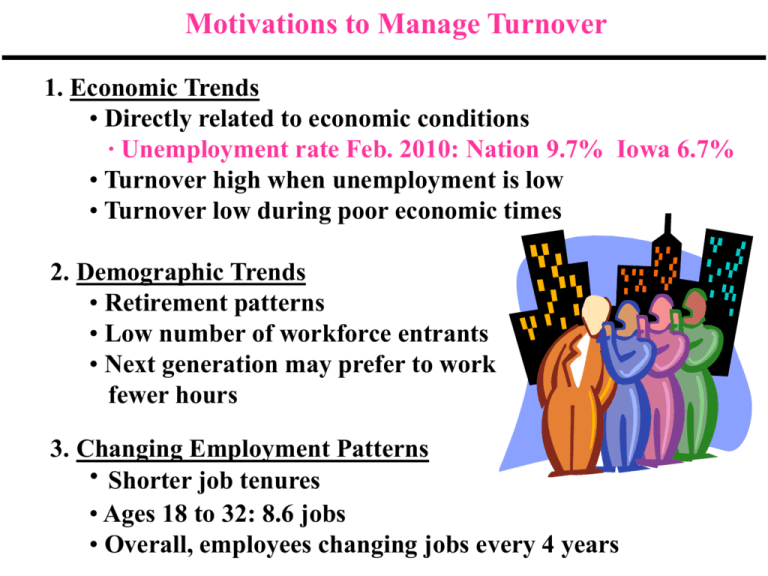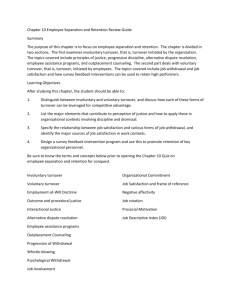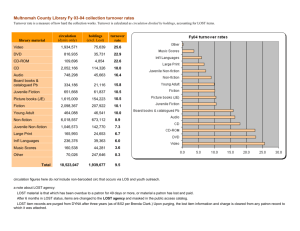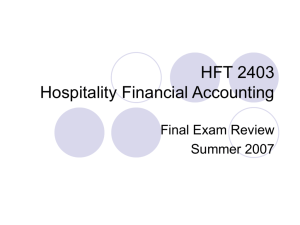TURNOVER COSTS
advertisement

Motivations to Manage Turnover 1. Economic Trends • Directly related to economic conditions ∙ Unemployment rate Feb. 2010: Nation 9.7% Iowa 6.7% • Turnover high when unemployment is low • Turnover low during poor economic times 2. Demographic Trends • Retirement patterns • Low number of workforce entrants • Next generation may prefer to work fewer hours 3. Changing Employment Patterns ∙ Shorter job tenures • Ages 18 to 32: 8.6 jobs • Overall, employees changing jobs every 4 years Motivations to Manage Turnover 4. Normal Voluntary Turnover? ● Fortune Magazine’s 100 Best Companies (next 2 slides) ● Company rate/level may not be ideal anyway (AZ Council) •1.6% month (Dec.), 2.7% (Aug) • 13 - 20% / year now normal • Some industries and low level service: 100 - 140% normal 5. Need to Consider Customer Satisfaction Sears also linked T/O to customer satisfaction ▲Stores w/high customer sat: 54% turnover ▲Stores w/low customer satisfaction: 83% turnover 6. Need to Manage (but not eliminate) Turnover ▪ Who is quitting? ▪ What are the replacement costs? 7. Need to Reduce High Replacement Costs (next slide) ▪ Direct ▪ Indirect Turnover Rates Among Fortune 100’s Best Potential Savings Company1 Number of Employees (US) Turnover Estimated Reducing Rate Turnover Cost Turnover 1% per employee2 Savings / year Merck 39,489 9% $7592 $2,765,000 Cerner 2,953 14% $8000 $240,000 Charles Schwab 18,863 12% $8329 $1,512,000 MBNA America Bank 16,960 15% $4800 $1,000,000 Average US Company 10,000 15.6% $5000 $500,000 Notes: 1. Based on Public Data from Fortune Magazine’s 100 Best Companies to work for January 2001. 2. Estimated Turnover Costs Calculated at 20% of most common entry level salary ($42,940) as provided in note 1. Fortune 100 Firms with Consistently Low Voluntary Turnover Company 2008/09/10 Best Companies Rank 2008/09 % Turnover S.C. Johnson 27/81/83 2/2 Herman Miller 96/89/97 3/5 Alcon Laboratories 60/74/- 3/3 Cisco Systems 6/6/16 4/5 General Mills 69/99/90 4/4 Devon Energy 48/13/20 4/4 SAS Institute 29/20/1 5/3 Mayo Clinic 59/63/55 5/5 Fortune Turnover Rates: Mental Health Jobs 66 Human Resource Assistant 14 Secretary 200 Maintenance Worker Driver Therapist 27 0 34 40 47 Cook Case Manager Teachers 92 Behavioral Health Technician 16 Teachers Aide 60 Supervisor 36 Clinical Director 100 Accountant 33 HR Manager 60 Controller Executive Director 0 0 50 100 150 200 Annual Turnover Rates 250 TURNOVER COSTS Based on Entry Level Salary of $47,097 Replacement Acquisition - Direct hiring costs - Other hiring costs Replacement Training - Pre-assignment - Learning curve (see learning curve graph) Other costs - Unabsorbed burden - Lost profit contribution TOTAL *Entry level salary of Fortune 500 employee (2010 figures) $1098 693 2833 795 2,549 1,452 $9,420 Percent of Standard Proficiency Attained Hypothetical Learning Curve for New Hires 100 80 60 40 20 0 1 25 50 75 Employment Duration (Days) 100 TURNOVER COST EXAMPLES BY COMPANY AND POSITION Company State govt, (LA) Machine works Insurance Position Protective services (police, wildlife & fisheries, guards) Salaried Machinist Hourly Machinist (both journeyman) Manager Software Project Leader Systems engineer Hospitality Hotel front desk-Miami Hotel front desk-NY Fast-food chain Store Manager Counter Person Source: Bulletin to Management, 6-17-99, Kepner & Tregoe, Jan. 1999 (Saratoga Institute Turnover Costing Model), SASHA Corp 2007 Cost $25,000 $102,376 $ 58,564 $ 79,672 $ 32,160 $ 34,365 $ 5688 $ 11609 $ 20,765 $ 1,204 Forms of Turnover • Nonvoluntary: Employer controlled (layoffs, terminations, downsizing) • Voluntary: Employee controlled (quits, retirements) • Gray Area: (spouse relocation, child/elder care problem, exit Primary Reason For Leaving In Nursing Sample Reasons Unknown Personal Reasons Death Retirement Poor Health Temporary Position Completed Prescribed Service or Course Geographic Factors:Job Too Far, Leaving City Family Illness or Home Duties To Stay Home To Attend School Pregnancy Marriage Enter Military Service Unsatisfactory Work Hours Work Too Difficult; Misunderstanding of Duties General Job Dissatisfaction Present Wages Inadequate Other Employment 10 15 0 0 0 0 0 30 0 5 5 0 20 0 5 0 0 0 10 0 5 10 15 20 25 Percent of Voluntary Leavers 30 35 Analyzing Forms of Turnover Among Nurses from A Managerial Perspective: Organizational Level Turnover 14.6% Voluntary 87% Functional 42% Involuntary 13% Dysfunctional 58% (7.37% rather than 14.6%) Turnover Measures 1. Separation Rate = # of employees who left during period avg. # of employees during period X 100 a. Jan. 1 - 20 employees 7 quit and are replaced, 2 new hires Jan 31 - 22 employees 7/(20 + 22)/2 = 7/21 = 1/3 = .33 .33 x 100 = 33% b. Growth scenario Feb. 1 - 22 employees 16 new hires, 7 quit & are replaced Feb. 28 - 38 employees 7/(22 + 38)/2 = 7/30 = .23 or 23% Turnover Measures (Continued) II. Instability Rate # of initial employees who leave during a period = # of initial employees X 100 a. Jan.: 7/20 = .35 or 35% b. Feb.: 7/22 = .32 or 32% III. Wastage Rate # of new employees who leave during a period = # of new members X 100 a. Between Feb. 1 & 28, 8 new hires quit: 8/16 = .50 or 50% IV. Avg. Length = Sum of length of service for each employee of Service # of members Predictors of Voluntary Turnover 1. Age Turnover (around ρ = -.14) Length of service ▪ side bets ▪ health insurance less problematic if coverage is continuous 3. Sex & family size Men & women quit at similar rates ↑ # of dependents → ↓ T/O 4. Pre-employment predictors: ▪ prior turnover behavior ▪ others in Barrick & Zimmerman Predictors of Voluntary Turnover 5. Personality ▪ Conscientiousness (ρ = -.20) ▪ Emotional stability (ρ = -.18) ▪ Agreeableness (ρ = -.25) ▪ Extraversion (ρ = -.04) [zero] ▪ Openness (ρ = .10) ▪ Self-confidence (B&Z) ▪ Decisiveness (B&Z) 6. Union presence 7. Attitudes (job satisfaction, organizational commitment; see upcoming Hom Griffeth model) 8. Pre-employment interventions (e.g., RJPs) Providing Job Candidates With Accurate and Complete Information About the New Job Reduces Turnover Sewing Machine Operators 40 11.1 11.5 6 West Point Cadets 50 33.8 Telephone Operators 27 19 Insurance Agents 35 15 Bank Tellers 22.4 U.S. Marines 33.1 Control Group 21.1 8.5 RJP Group Nurses 0 10 20 30 Turnover Rates 40 50 60 Predictors of Voluntary Turnover 9. Work group size 10. Job enrichment 11. Task repetitiveness 12. Considerate leadership 13. Stress 14. Perceived job availability 15. Withdrawal behaviors: Lateness (rho = .06) and absenteeism (rho = .33) 16. Job performance (low performers quit more than high performers but low and high performers quit more than avg. performers) Hom-Griffeth Model of Turnover Satisfaction Influences: •Job Complexity •Role Stress •Group Cohesion •Compensation •Leader-Member Relations •Met Expectations •Negative Affectivity Commitment Influences: •Procedural Justice •Attraction of Internal Roles •Job Security •Job Investments •Extra Organizational Conflicts •Conditions of Job Entry •Commitment Propensity Job Satisfaction Organizational Commitment Labor Market: •Unemployment •Knowledge of Other Jobs •Relocation Costs Shocks Decisions to Quit Job-Seeking Costs & Benefits: Turnover Costs & Benefits Job Search Evaluate Alternatives Resignation POSSIBLE POSITIVE CONSEQUENCES OF TURNOVER 1. Displacement of poor performers 2. Increased satisfaction among stayers 3. Infusion of new knowledge/technology via replacements 4. Facilitate organizational change 5. Increased internal mobility opportunities 6. Decrease in other “withdrawal” behaviors 7. Opportunities for cost reduction RECOMMENDATIONS FOR INCREASED UNDERSTANDING OF TURNOVER 1. Focus on occupational differences (more understanding of blue collar turnover needed) 2. Separate voluntary from non-voluntary turnover 3. Study turnover in the context of economic conditions and historical changes (e.g., new generations of employees, dual career families, new employment patterns of more frequent job changes). PRACTICAL STRATEGIES FOR MANAGING TURNOVER 1. Hire more carefully 2. Use pre-employment interventions (see example) 3. Promote job satisfaction 4. Promote job autonomy through job enrichment 5. Use small work groups 6. Reduce task repetitiveness 7. Improve human relations skills of supervisors 8. Reduce stress 9. Promote organizational commitment (e.g., career counseling; side bets) 10. Emphasize person/job fit 11. Address non-work sources of turnover (e.g., elder care, EAPs) Demonstrating Cost Savings of RJP Retention Strategy Practical Application of a Control Group Evaluation Comparison Turnover Number of Turnover Total Groups Rates (%) Leavers (No. of Cost per Turnover New Employees Leaver ($) Costs ($) Per 100) Control Realistic Job Preview Recipients 17 17 6,018 102,306 5 5 6,018 30,090 Cost Savings (Difference) Based on public accounting firm case study, 1999 72,216 Four “Do’s and Don’ts” for Managing Turnover • Don’t fail to make the business case for managing turnover—Do provide cost/ benefit data • Don’t fail to approach turnover strategically--Do plan to attract & retain talent independent of market conditions • Don’t just throw money at the problem—Do realize that compensation is often not the most important determinant of turnover • Don’t ignore employee priorities—Do appreciate that employees first loyalty is to their own careers & that their assessment of prospects in and outside of your company will drive their turnover behavior. Wright & Bonett (2007) • Job sat & Ψ well-being (PWB) as predictors of T/O • Why examine in a highly paid sample? • Authors assert that job sat is a good but insufficient predictor of T/O. Metaanalysis suggests ρ = -.19 (p. 143). Weakness due to presence of moderator variables. • What is a moderator variable? Moderator Variables ∙When the relationship between two variables depends on a third variable (level of, presence or absence) ∙When a combination of two things becomes superpredictive or the presence of a third factor makes a difference: time spent shopping w/spouse Marital satisfaction Gender (True for women, not true for men) ∙ What moderator is proposed to affect relations between job satisfaction and turnover? How does it work? Job Satisfaction ↓Voluntary Turnover PWB (Such that the relationship will be weak or zero when PWB is high & more strongly negative when PWB is low) ∙ Why is PWB thought to have this effect? (a) Conservation of Resources Model (b) Research finding: Job Sat Job Perf ■PWB high, stronger positive ■PWB low, weaker positive PWB Wright & Bonett (2007) • What was the sample? • Measures? · Vol T/O 20% annually, lag (T2) 2 years. Others T1 · Job perf measured by supervisory assessment · PWB, job sat measured by employee surveys • Review correlations in Table 1 • What role did job sat and PWB play in predicting T/O? Was the hypothesis supported? Review Table 2 and Figure 1 Wright & Bonett: Implications • Do you get more “bang for the buck” when you hire those high in PWB? • Authors point out firm is losing very best and worst performers (as also suggested by Steele et al.). How can that be addressed? • Notes potential “halo effect” limitation. Barrick & Zimmerman • Can “people problems” like turnover be avoided by selection using dispositional factors (e.g., personality)? • How well do RJPS do, using evidence-based management? (Tries to build on its success) • What is biodata and why are some forms not used? What types of biodata are hypothesized to predict turnover? (H1-H3) • What are pre-employment factors known as “clear purpose” and “disguised purpose” predictors? Barrick & Zimmerman Re-worded Hypotheses (so supportive correlations will be negative in direction) • • • • • • • H1: H2: H3: H4: H5: H6: H7: ↑ Prior Tenure → ↓ Turnover ↑ Were Referred → ↓ Turnover ↑ Friends & Family → ↓ Turnover ↑ Intent to Stay → ↓ Turnover ↑ Desire for Job → ↓ Turnover ↑ Self Confidence → ↓ Turnover ↑ Decisiveness → ↓ Turnover Revised Table 2 Using Combined Samples Order of Entry #1 Order of Entry 2 Step Step Step Step Step Step 1 2 3 1 2 3 Biodat a Disguise d Purpose Clear Purpose Clear Purpos e Disguise d Purpose Biodata Adjusted R .29 .33 .33 .18 .22 .33 Change (∆) in R --- .05 .01 --- .06 .11 Upshot: Biodata best predictor, even when considered last (order #2). Clear purpose measures not useful when entered last; too transparent. Disguised purpose measures helpful in both entry orders (.05 and .06). Barrick & Zimmerman • Table 3 just an alternate statistical methodology. Table 4 indicates that use of these measures would not result in adverse impact on protected subgroups. • Practical implications: Biodata indicators examined here, along with “disguised purpose” measures of self confidence and decisiveness predict turnover as well as RJPs. (RJP: ρ = -.09; R2 =.01 vs. adj. R =.33 (Table 2) which yields adj. R2 = .11) • The value may be in combining biodata and personality with job factors (like job sat) to reduce turnover. Hausknecht et al. (2009) • Included because it repositions the turnover topic to a discussion of employee retention • Why are “blanket” retention policies problematic? • What retention factors are hypothesized to retain high performers? Hausknecht et al. (2009) • What retention factors are hypothesized to retain high performers? • What would low performers cite? • What retention factors were hypothesized to retain hourly employees (H2)? • What would managerial and professional employees cite? Hausknecht et al. (2009) • What was the sample? • How was job performance measured? • Were the hypotheses supported? Findings were mixed. Not sure I care! Hausknecht et al. (2009) • More interested in the top reasons for retention: job sat, extrinsic rewards, constituent attachments, org commitment, org prestige. • And appreciation of targeted strategies: High performers & non-hourly cited advancement opportunities & org prestige as most important for staying. Low performers & hourly cited extrinsic rewards as most important for staying. Holtom et al. • Article rich in practical suggestions and examples of retention • Emphasis is on aligning the retention strategy with the business strategy • Reinforces Hausknecht article in asserting that the reasons people quit are distinct from the reasons people stay • What is the “overlooked” reason they believe people stay and how can it be increased?








